Old World babbler
The Old World babblers or Timaliidae are a family of mostly Old World passerine birds. They are rather diverse in size and coloration, but are characterised by soft fluffy plumage. These are birds of tropical areas, with the greatest variety in Southeast Asia and the Indian subcontinent. The timaliids are one of two unrelated groups of birds known as babblers, the other being the Australasian babblers of the family Pomatostomidae (also known as pseudo-babblers).
| Babblers | |
|---|---|
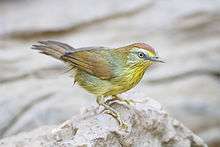 | |
| Pin-striped tit-babbler, (Mixornis gularis) | |
| Scientific classification | |
| Kingdom: | Animalia |
| Phylum: | Chordata |
| Class: | Aves |
| Order: | Passeriformes |
| Superfamily: | Sylvioidea |
| Family: | Timaliidae Vigors & Horsfield, 1827 |
| Genera | |
|
See article text | |
Morphological diversity is rather high; most species resemble "warblers", jays or thrushes. This group is among those Old World bird families with the highest number of species still being discovered.
Characteristics
Timaliids are small to medium birds. They have strong legs, and many are quite terrestrial. They typically have generalised bills, similar to those of a thrush or warbler, except for the scimitar babblers which, as their name implies, have strongly decurved bills. Most have predominantly brown plumage, with minimal difference between the sexes, but many more brightly coloured species also exist.[1]
This group is not strongly migratory, and most species have short rounded wings, and a weak flight. They live in lightly wooded or scrubland environments, ranging from swamp to near-desert. They are primarily insectivorous, although many will also take berries, and the larger species will even eat small lizards and other vertebrates.[1]
Typical babblers live in communities of around a dozen birds, jointly defending a territory. Many even breed communally, with a dominant pair building a nest, and the remainder helping to defend and rear their young. Young males remain with the group, while females move away to find a new group, and thus avoid inbreeding. They make nests from twigs, and hide them in dense vegetation.[1]
Taxonomy and systematics
The systematics of Old World babblers have long been contested. During much of the 20th century, the family was used as a "wastebin taxon" for numerous hard-to-place Old World songbirds (such as Picathartidae or the wrentit). Ernst Hartert was only half-joking when in 1910 he summarized this attitude with the statement that, in the passerines: "Was man nicht unterbringen kann, sieht man als Timalien an." (What one can't place systematically is considered an Old World babbler).[2]
The most obviously misplaced taxa were removed piecemeal towards the end of the last century. Since then, with the aid of DNA sequence data, it has been confirmed that even the remaining group is not monophyletic. Analysis of mtDNA cytochrome b and 12S/16S rRNA data (Cibois 2003a) spread the Timaliidae that were studied across what essentially was a badly resolved polytomy with Old World warblers and white-eyes. As the typical warblers (genus Sylvia) grouped with some presumed timaliids (such as the fulvettas), it was suggested that some Sylviidae should be moved to the Timaliidae.
As this would include the type genus of the latter, this would lead to a nomenclatorial problem requiring ICZN intervention (Cibois 2003b) and was, at that time, not sensible in any case as the phylogeny of the remaining Old World warblers had not been fully resolved either. The problem with such an approach would be — as many Old World warblers have not been studied with the new results in mind and neither have a number of timaliids — to risk creating a huge, ill-defined family-level clade; consequently, this approach seems to have been put on hold for the time being in favor of a general resorting of the Sylvioidea.
Alström et al. (2006) supported the taxonomic proposal of Cibois (2003b), "if the Timaliidae and several groups of warblers are recognized at the same family level" but of course it is not necessary to unite them to achieve monophyly in both. Notably, one of the few conclusions beyond genus level which received quite robust support in Cibois (2003a) was the distinctness of Sylvia and the related "babblers" from the Timaliidae sensu stricto. Thus, for the time being, it seems wisest to maintain the Sylviidae and Timaliidae as distinct and just split off or move about genera as needed to achieve monophyly.
The parrotbills are somewhat tit-like birds that in the past were moved about between the timaliids, the tits, and distinct family status (under the telling name Paradoxornithidae — literally, "puzzling birds"). They are likely not a distinct family; rather, they belong into the Sylvia clade (Cibois 2003a, Alström et al. 2006).
The relationships of the white-eyes (presently Zosteropidae) are not resolved at present. Based on nDNA RAG-1 and c-mos sequence data, Barker et al. (2002) found them likelier to group closer to the timaliids proper than to Sylvia and allies, as did Cibois (2003a). Combining data from nDNA c-myc exon 3, RAG-1 and myoglobin intron 2 sequences with that of mtDNA cytochrome b (Ericson & Johansson 2003) supports their scenario as does a restudy using the myoglobin intron 2 and cytochrome b sequences of a wider (though not denser) range of taxa (Alström et al. 2006)
On the other hand, DNA-DNA hybridization (Sibley & Ahlquist 1990) placed the white-eyes closer to Sylvia. This method is nowadays considered inferior to comparison of long and various DNA sequences, however. No molecular study thus far could resolve the white-eyes' relationships with sufficient confidence beyond the mere fact that they form a clade with "core" Sylviidae and "core" Timaliidae. In this assemblage, they most likely form a monophyletic lineage with the yuhinas (and possibly other "babblers"). Consequently, were the Zosteropidae to be retained as a family, these would be moved there.
List of genera
The family as currently constituted includes 53 species divided into the following ten genera:[3]
| Image | Genus | Living species |
|---|---|---|
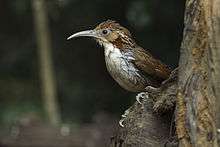 | Erythrogenys Baker, 1930 – scimitar-babblers |
|
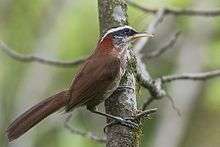 | Pomatorhinus Horsfield, 1821 – scimitar-babblers |
|
.jpg) | Spelaeornis David & Oustalet, 1877 – typical wren-babblers |
|
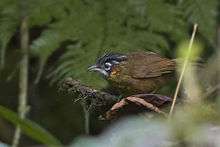 | Stachyris Hodgson, 1844 |
|
.jpg) | Cyanoderma Salvadori, 1874[4] |
|
.jpg) | Dumetia (Franklin, 1831) |
|
.jpg) | Mixornis Blyth, 1842 – tit-babblers |
|
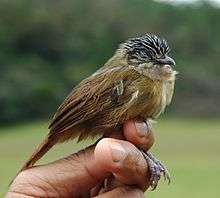 | Macronus Jardine & Selby, 1835 – tit-babblers |
|
.jpg) | Timalia Horsfield, 1821 |
|
| Melanocichla Sharpe, 1883 |
| |
References
- Perrins, C. (1991). Forshaw, Joseph (ed.). Encyclopaedia of Animals: Birds. London: Merehurst Press. pp. 188–190. ISBN 1-85391-186-0.
- Hartert, Ernst (1910). Die Vögel der paläarktischen Fauna systematische Übersicht der in Europa, Nord-Asien und der Mittelmeerregion vorkommenden Vögel (in German). Volume 1. Berlin: R. Friedländer & Sohn. p. 469.
- Gill, Frank; Donsker, David, eds. (2017). "Babblers & fulvettas". World Bird List Version 7.3. International Ornithologists' Union. Retrieved 31 July 2017.
- Collar, N. J.; Robson, C. (2016). "Scimitar-babblers and allies". In del Hoyo, J.; Elliott, A.; Sargatal, J.; Christie, D. A.; de Juana, E. (eds.). Handbook of the Birds of the World. Volume 2: Passerines. Barcelona: Lynx Edicions.
- Alström, P; Ericson, P. G.; Olsson, U; Sundberg, P (2006). "Phylogeny and classification of the avian superfamily Sylvioidea". Molecular Phylogenetics & Evolution. 38 (2): 381–97. doi:10.1016/j.ympev.2005.05.015. PMID 16054402.
- Barker, F. K.; Barrowclough, G. F.; Groth, J. G. (2002). "A phylogenetic hypothesis for passerine birds: Taxonomic and biogeographic implications of an analysis of nuclear DNA sequence data". Proceedings of the Royal Society B: Biological Sciences. 269 (1488): 295–308. doi:10.1098/rspb.2001.1883. PMC 1690884. PMID 11839199.
- Barker, F. K.; Cibois, A; Schikler, P; Feinstein, J; Cracraft, J (2004). "Phylogeny and diversification of the largest avian radiation". Proceedings of the National Academy of Sciences of the United States of America. 101 (30): 11040–5. Bibcode:2004PNAS..10111040B. doi:10.1073/pnas.0401892101. PMC 503738. PMID 15263073.
- Beresford, P; Barker, F.K; Ryan, P.G; Crowe, T.M (2005). "African endemics span the tree of songbirds (Passeri): molecular systematics of several evolutionary 'enigmas'". Proceedings of the Royal Society B: Biological Sciences. 272 (1565): 849–858. doi:10.1098/rspb.2004.2997. PMC 1599865. PMID 15888418.
- Cibois, Alice (2003). "Mitochondrial DNA phylogeny of babblers (Timaliidae)". The Auk. 120: 35. doi:10.1642/0004-8038(2003)120[0035:MDPOBT]2.0.CO;2.
- Cibois, Alice (2003b). "Sylvia is a babbler: taxonomic implications for the families Sylviidae and Timaliidae". Bull. B. O. C. 123: 257–261.
- Cibois, Alice; Slikas, Beth; Schulenberg, Thomas S.; Pasquet, Eric (2001). "An endemic radiation of Malagasy songbirds is revealed by mitochondrial DNA sequence data". Evolution. 55 (6): 1198. doi:10.1554/0014-3820(2001)055[1198:AEROMS]2.0.CO;2. PMID 11475055.
- Cibois, Alice; Kalyakin, Mikhail V.; Lian-Xian, Han; Pasquet, Eric (2002). "Molecular phylogenetics of babblers (Timaliidae): Revaluation of the genera Yuhina and Stachyris". Journal of Avian Biology. 33 (4): 380. doi:10.1034/j.1600-048X.2002.02882.x.
- Collar, N. J. & Robson, C. 2007. Family Timaliidae (Babblers) pp. 70–291 in; del Hoyo, J., Elliott, A. & Christie, D.A. eds. Handbook of the Birds of the World, Vol. 12. Picathartes to Tits and Chickadees. Lynx Edicions, Barcelona.
- Ericson, Per G.P.; Johansson, Ulf S. (2003). "Phylogeny of Passerida (Aves: Passeriformes) based on nuclear and mitochondrial sequence data". Molecular Phylogenetics and Evolution. 29 (1): 126–38. doi:10.1016/S1055-7903(03)00067-8. PMID 12967614.
- Jonsson, Knud A.; Fjeldsa, Jon (2006). "A phylogenetic supertree of oscine passerine birds (Aves: Passeri)". Zoologica Scripta. 35 (2): 149. doi:10.1111/j.1463-6409.2006.00221.x.
- Nguembock, Billy; Fjeldså, Jon; Tillier, Annie; Pasquet, Eric (2007). "A phylogeny for the Cisticolidae (Aves: Passeriformes) based on nuclear and mitochondrial DNA sequence data, and a re-interpretation of an unique nest-building specialization". Molecular Phylogenetics and Evolution. 42 (1): 272–86. doi:10.1016/j.ympev.2006.07.008. PMID 16949311.
- Pasquet, Eric; Bourdon, Estelle; Kalyakin, Mikhail V.; Cibois, Alice (2006). "The fulvettas (Alcippe, Timaliidae, Aves): a polyphyletic group". Zoologica Scripta. 35 (6): 559. doi:10.1111/j.1463-6409.2006.00253.x.
- Reddy, Sushma; Cracraft, Joel (2007). "Old World Shrike-babblers (Pteruthius) belong with New World Vireos (Vireonidae)". Molecular Phylogenetics and Evolution. 44 (3): 1352. doi:10.1016/j.ympev.2007.02.023. PMID 17412613.
- Schulenberg, T.S. (2003): The Radiations of Passerine Birds on Madagascar. In: Goodman, Steven M. & Benstead, Jonathan P. (eds.): The Natural History of Madagascar: 1130–1134. University of Chicago Press. ISBN 0-226-30306-3
- Sibley, Charles Gald & Ahlquist, Jon Edward (1990): Phylogeny and classification of birds. Yale University Press, New Haven, Conn.
External links
| Wikimedia Commons has media related to Timaliidae. |
- Babbler videos on the Internet Bird Collection